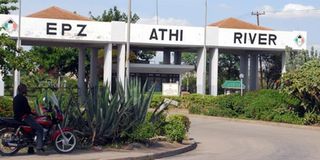Consultant sought to plan leather city

The entrance to the Export Processing Zone in Athi River. FILE PHOTO | SALATON NJAU |
What you need to know:
- Government engages revival gear.
- Winners to come up with framework for land use and cost estimates.
The government is seeking a consultant to carry out a feasibility study on establishing a proposed leather city in Machakos County.
“The ministry (of Industrialisation) therefore invites eligible firms to submit their bids to provide services of carrying out the feasibility study and develop a master plan for proposed leather industrial park in Athi River, Kenya,” an advert on Monday said.
EARN MORE REVENUE
The planned project will sit on a 500-acre Export Processing Zone Authority land at Kinanie in Athi River. Its objective is to earn more revenue and create more jobs in the country.
The successful firm is expected to develop a master plan to include land use, utility services and infrastructure and provide cost estimates.
It will market and promote the plans with the objective of attracting local and foreign investors as well as provide financing models and funds mobilisation strategies for implementing the project.
Industrialisation Cabinet Secretary Adan Mohamed early this year said Sh1 billion will be allocated in the coming financial year to kick off the project that is expected to cost Sh7 billion in infrastructure development alone when completed.
Establishing the park is among the recommendations of a task force he appointed to find out how the leather industry can be improved so that it can contribute more to the national economy.
ARE HELD BACK
“We have 15 tanneries and there is potential to have more, but we are held back by the huge investment required, the need for effluent treatment plant systems and export of raw materials. The sector generates Sh10 billion, but has the capacity to earn 10 times more if we move from export of wet blue (semi-processed) to finished leather,” he said.
The government has identified leather and textiles as focus areas in plans to increase exports and create jobs in a relatively short time.
This year, the Treasury allocated Sh3 billion to the two sectors to increase production.
The first phase of the project will target 15 tanneries, each with a production capacity of 10 tonnes of raw hides and skins a day and at least 10,000 pairs of shoes, handbags, leather garments and industrial gloves.
Mr Mohamed said the sector faces huge investment capital requirements that include water, power, and effluent treatment, which had hindered firms from going into value addition, leading to over 90 per cent of the skins and hides being exported as raw or semi processed.
DEVELOP INFRASTRUCTURE
“The government will develop infrastructure that includes water, power, sewage and effluent disposal systems. This way we should be able to see more investors in the sector, more players moving from the export of wet blue to finished products and more small and medium enterprises making leather products,” he said.





